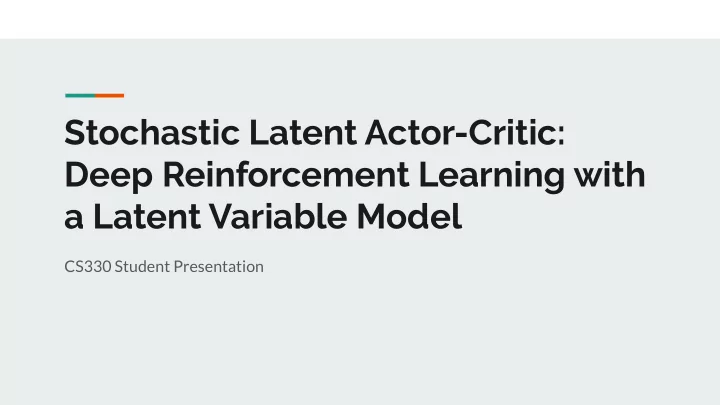

Stochastic Latent Actor-Critic: Deep Reinforcement Learning with a Latent Variable Model CS330 Student Presentation
Table of Contents Motivation & problem ● Method overview ● Experiments ● Takeaways ● Discussion (strengths & weaknesses/limitations) ●
Motivation We would like to use reinforcement learning algorithms to solve tasks using only low-level ● observations, such as learning robotic control using only unstructured raw image data The standard approach relies on sensors to obtain information that would be helpful for learning ● Learning from only image data is hard because the RL algorithm must learn both a useful ● representation of the data and the task itself This is called the representation learning problem ●
Approach The approach of the paper is a two-fold approach: 1. Learn a predictive stochastic latent variable model for given high-dimensional data (i.e., images) 2. Perform learning in the latent space of the latent variable model
The Stochastic Latent Variable model We would like our latent variable model to represent a partially-observable Markov Decision ● Process (POMDP) The authors choose a graphical model for the latent variable model ● Previous work have used mixed deterministic-stochastic models, but SLAC’s model is purely ● stochastic The graphical model will be trained using amortized variational inference ●
Graphical model representation of POMDP Since we can only observe part of the true state, we need past information to infer the next latent ● state We can derive an evidence lower bound (ELBO) for POMDP: ●
Learning in the Latent Space The SLAC algorithm can be viewed as an extension of the Soft Actor-Critic algorithm (SAC) ● Learning is done in the maximum entropy setting , where we seek to maximize the entropy along ● with the expected reward: The entropy term encourages exploration ●
Soft Actor-Critic (SAC) As an actor-critic method, SAC learns both value function approximators (the critic ) and a policy ● (the actor ) SAC is trained using alternating policy evaluation and policy improvement ● Training is done in the latent space (i.e., in the state space z ) ●
Soft Actor Critic (SAC), con’t SAC learns two Q-networks, a V-network, and a policy network ● Two Q-networks are used to mitigate overestimation bias ● A V-network is used to stabilize training ● Taking gradients through the expectations is done using the reparametrization trick ●
Putting it all Together Finally, both the latent variable model and agent are trained together ● The full SLAC model has two layers of latent variables ●
Image-based Continuous Control Tasks Four tasks from DeepMind Control Suite ● Cheetah run Walker walk Ball-in-cup catch Finger spin Four tasks from OpenAI Gym ● Cheetah Walker Hopper Ant
Comparison with other models SAC ● ○ Off-policy actor-critic algorithm, learning directly from images or true states D4PG ● ○ Off-policy actor-critic algorithm, learning directly from images PlaNet ● ○ Model-based RL method for learning directly from images ○ Mixed deterministic/stochastic sequential latent variable model ○ No explicit policy learning yet used model predictive control (MPC) DVRL ● ○ On-policy model-free RL algorithm ○ Mixed deterministic/stochastic latent-variable POMDP model
Results on DeepMind Control Suite (4 tasks) Sample efficiency of SLAC is comparable or better than both model-based and ● model-free Outperforms DVRL ● Efficient off-policy RL algorithm take advantage of the learned representation ○
Results on OpenAI Gym (4 tasks) - Tasks are more challenging than DeepMind Control Suite tasks - Rewards not shaped, not bounded between 0 and 1 - More complex dynamics - Episode terminate on failure - PlaNet unable to solve last three tasks but obtains sub-optimal policy on cheetah
Robotic Manipulation Tasks - 9-DoF 3-fingered DClaw robot Push a door Close a drawer Reach out and pick up an object *Note: SLAC algorithm achieves above actions
Robotic Manipulation Tasks (continued) - 9-DoF 3-fingered DClaw robot - Goal : rotate a valve from various starting positions to various desired goal locations - Three different settings: 1. Fixed goal position 2. Random goal from 3 options : 3. Random goal :
Results Goal : Turning a valve to a desired location Takeaways: - For fixed goal setting, all performances are similar - For three random goal setting, SLAC and SAC from raw images performs well - For random goal setting , SLAC performs better than SAC from raw images / comparable to SAC from states
Latent Variable Models Six different models: ● Non-sequential VAE ○ PlaNet (Mixed deterministic/stochastic Model) ○ Simple Filtering (without factoring model) ○ Fully deterministic ○ Mixed deterministic/stochastic Model ○ Fully stochastic ○ Under fixed RL framework of SLAC ● Takeaway: - Fully stochastic model outperforms others
SLAC paper summary Propose a SLAC RL algorithm for learning from high-dimensional image inputs ● Combined off-policy model-free RL with representation learning via a sequential stochastic state space model ● SLAC’s fully stochastic model outperforms other latent variable models ● Achieved improved sample efficiency and final task performance ● Four DeepMind Control Suite tasks and four OpenAI Gym tasks ○ Simulation on robotic manipulation tasks (9-DoF 3-fingered DClaw robot on four tasks) ○
Limitations For fairness , performance evaluations for other models seems necessary ● not just SLAC RL framework, compare on different latent variable models ○ States benefits of using two layers of latent variables ● Insufficient explanation on why it brings good balance ○ Reward function choice for simulated robotics tasks are not well explained ● Insufficient explanation on weak performances of SAC from true states on three random ● goal setting (refer to previous slide) Performance on other image-based continuous control tasks ●
Appendix A (reward functions)
Appendix B (SLAC algorithm)
Log-likelihood of the observations can be bounded
Recommend
More recommend